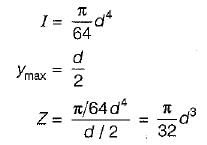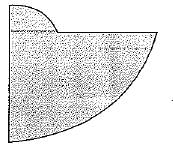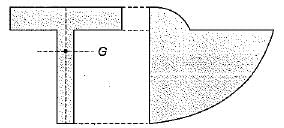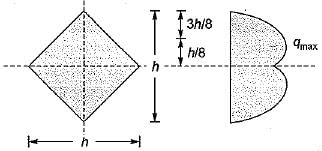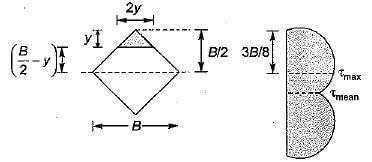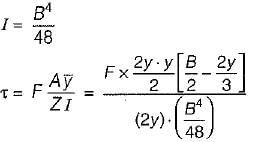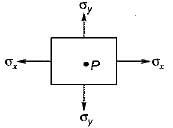All Exams >
Civil Engineering (CE) >
6 Months Preparation for GATE Civil Engg >
All Questions
All questions of Shear Stresses in Beams for Civil Engineering (CE) Exam
Which stress comes when there is an eccentric load applied? - a)Shear stress
- b)Bending stress
- c)Tensile stress
- d)Thermal stress
Correct answer is option 'B'. Can you explain this answer?
Which stress comes when there is an eccentric load applied?
a)
Shear stress
b)
Bending stress
c)
Tensile stress
d)
Thermal stress
|
|
Pranav Singh answered |
When there is an eccentric load it means that the load is at some distance from the axis. This causes compression in one side and tension on the other. This causes bending stress.
Shear center is the point in or outside a section through which the shear force applied produces only- a)non-zero bending
- b)non-zero twisting
- c)zero bending
- d)zero twisting and bending
Correct answer is option 'A'. Can you explain this answer?
Shear center is the point in or outside a section through which the shear force applied produces only
a)
non-zero bending
b)
non-zero twisting
c)
zero bending
d)
zero twisting and bending

|
Sahana Choudhary answered |
Shear center is the point in or outside a section through which the shear force applied produces no torsion or twist of the member.
Select the WRONG statements:- a)A beam of uniform strength will have varying cross-section.
- b)I section beams are most economical.
- c)For a beam subjected to pure bending, the stress intensity in any fibre is proportional to the distance of the fibre from the neutral axis.
- d)The moment of inertia of any area is always least with respect to its radius of gyration.
Correct answer is option 'D'. Can you explain this answer?
Select the WRONG statements:
a)
A beam of uniform strength will have varying cross-section.
b)
I section beams are most economical.
c)
For a beam subjected to pure bending, the stress intensity in any fibre is proportional to the distance of the fibre from the neutral axis.
d)
The moment of inertia of any area is always least with respect to its radius of gyration.
|
|
Nitin Joshi answered |
The moment of inertia of any area is always least with repsectto its center axis (not w.r.t radius of gyration).
The cross-section of a beam in bending is as shown in the figure below. It is subjected to a shear force acting in the plane of cross-section.
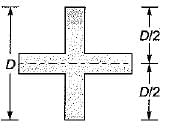
Which among the following figure shows the correct shear stress distribution across the depth of the cross-section of the beam?- a)

- b)
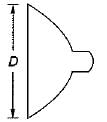
- c)

- d)

Correct answer is option 'C'. Can you explain this answer?
The cross-section of a beam in bending is as shown in the figure below. It is subjected to a shear force acting in the plane of cross-section.

Which among the following figure shows the correct shear stress distribution across the depth of the cross-section of the beam?

Which among the following figure shows the correct shear stress distribution across the depth of the cross-section of the beam?
a)

b)

c)

d)


|
Devika Tiwari answered |
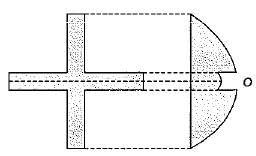
The distribution will be parabolic and shear stress will suddenly drop at larger width point. In the larger width portion, it also varies parabolically.
The steel bars in reinforced cement concrete beam are located at- a)top
- b)bottom
- c)center
- d)neutral axis
Correct answer is option 'B'. Can you explain this answer?
The steel bars in reinforced cement concrete beam are located at
a)
top
b)
bottom
c)
center
d)
neutral axis
|
|
Anshu Patel answered |
Reinforced cement concrete beams consist of concrete and steel bars. The steel bars are used to reinforce the concrete and provide tensile strength to the structure. The location of the steel bars in the reinforced cement concrete beam is an important design consideration as it affects the strength and durability of the structure.
Location of steel bars: Bottom
The steel bars in reinforced cement concrete beam are located at the bottom. This is because of the following reasons:
1. Tensile forces: The steel bars provide tensile strength to the structure. Tensile forces are generated at the bottom of the beam when it is subjected to a bending moment. Therefore, the steel bars are placed at the bottom to resist these forces.
2. Compression forces: The concrete in the beam provides compressive strength to the structure. Compression forces are generated at the top of the beam when it is subjected to a bending moment. Therefore, the concrete is placed at the top to resist these forces.
3. Shear forces: The steel bars also help to resist the shear forces that are generated in the beam. Shear forces are generated when a beam is subjected to a transverse load. Placing the steel bars at the bottom helps to resist these forces.
4. Corrosion: The steel bars are susceptible to corrosion when they are exposed to moisture and other environmental factors. Placing them at the bottom helps to protect them from corrosion as they are not exposed to the elements.
In summary, the steel bars in reinforced cement concrete beam are located at the bottom to provide tensile strength, resist compression and shear forces, and protect them from corrosion.
Location of steel bars: Bottom
The steel bars in reinforced cement concrete beam are located at the bottom. This is because of the following reasons:
1. Tensile forces: The steel bars provide tensile strength to the structure. Tensile forces are generated at the bottom of the beam when it is subjected to a bending moment. Therefore, the steel bars are placed at the bottom to resist these forces.
2. Compression forces: The concrete in the beam provides compressive strength to the structure. Compression forces are generated at the top of the beam when it is subjected to a bending moment. Therefore, the concrete is placed at the top to resist these forces.
3. Shear forces: The steel bars also help to resist the shear forces that are generated in the beam. Shear forces are generated when a beam is subjected to a transverse load. Placing the steel bars at the bottom helps to resist these forces.
4. Corrosion: The steel bars are susceptible to corrosion when they are exposed to moisture and other environmental factors. Placing them at the bottom helps to protect them from corrosion as they are not exposed to the elements.
In summary, the steel bars in reinforced cement concrete beam are located at the bottom to provide tensile strength, resist compression and shear forces, and protect them from corrosion.
If a beam of constant section is subjected throughout its length to a uniform bending moment, it will bend to- a)a circular arc
- b)a parabolic arc
- c)a catenary
- d)elliptical shape
Correct answer is option 'A'. Can you explain this answer?
If a beam of constant section is subjected throughout its length to a uniform bending moment, it will bend to
a)
a circular arc
b)
a parabolic arc
c)
a catenary
d)
elliptical shape

|
Devansh Banerjee answered |
Bending of a beam under uniform bending moment
When a beam is subjected to a uniform bending moment throughout its length, it undergoes bending in the form of a circular arc. This is because the bending moment produces a curvature in the beam, and the curvature of a circular arc is the most natural and uniform form of curvature.
Explanation
When a beam is subjected to a uniform bending moment, the beam experiences a moment of force that varies linearly along its length. This moment of force produces a curvature in the beam, which is proportional to the moment of force and the flexural rigidity of the beam. The flexural rigidity of a beam depends on its geometry and material properties, and it determines the resistance of the beam to bending.
When the bending moment is uniform along the length of the beam, the curvature of the beam is also uniform. In this case, the beam bends in the form of a circular arc, with the center of curvature located at the midpoint of the beam. The radius of curvature of the arc is proportional to the bending moment and the flexural rigidity of the beam.
The circular arc is the most natural and uniform form of curvature for a beam under uniform bending moment, because it minimizes the bending stresses and strains in the beam. The circular arc distributes the bending stresses and strains evenly along the length of the beam, and it ensures that the beam undergoes pure bending without any axial or shear deformation.
Conclusion
In summary, a beam of constant section that is subjected throughout its length to a uniform bending moment will bend in the form of a circular arc. This bending is the most natural and uniform form of bending for a beam under uniform bending moment, and it ensures that the beam undergoes pure bending without any axial or shear deformation.
When a beam is subjected to a uniform bending moment throughout its length, it undergoes bending in the form of a circular arc. This is because the bending moment produces a curvature in the beam, and the curvature of a circular arc is the most natural and uniform form of curvature.
Explanation
When a beam is subjected to a uniform bending moment, the beam experiences a moment of force that varies linearly along its length. This moment of force produces a curvature in the beam, which is proportional to the moment of force and the flexural rigidity of the beam. The flexural rigidity of a beam depends on its geometry and material properties, and it determines the resistance of the beam to bending.
When the bending moment is uniform along the length of the beam, the curvature of the beam is also uniform. In this case, the beam bends in the form of a circular arc, with the center of curvature located at the midpoint of the beam. The radius of curvature of the arc is proportional to the bending moment and the flexural rigidity of the beam.
The circular arc is the most natural and uniform form of curvature for a beam under uniform bending moment, because it minimizes the bending stresses and strains in the beam. The circular arc distributes the bending stresses and strains evenly along the length of the beam, and it ensures that the beam undergoes pure bending without any axial or shear deformation.
Conclusion
In summary, a beam of constant section that is subjected throughout its length to a uniform bending moment will bend in the form of a circular arc. This bending is the most natural and uniform form of bending for a beam under uniform bending moment, and it ensures that the beam undergoes pure bending without any axial or shear deformation.
Chapter doubts & questions for Shear Stresses in Beams - 6 Months Preparation for GATE Civil Engg 2025 is part of Civil Engineering (CE) exam preparation. The chapters have been prepared according to the Civil Engineering (CE) exam syllabus. The Chapter doubts & questions, notes, tests & MCQs are made for Civil Engineering (CE) 2025 Exam. Find important definitions, questions, notes, meanings, examples, exercises, MCQs and online tests here.
Chapter doubts & questions of Shear Stresses in Beams - 6 Months Preparation for GATE Civil Engg in English & Hindi are available as part of Civil Engineering (CE) exam.
Download more important topics, notes, lectures and mock test series for Civil Engineering (CE) Exam by signing up for free.
6 Months Preparation for GATE Civil Engg
488 videos|1261 docs|878 tests
|

Contact Support
Our team is online on weekdays between 10 AM - 7 PM
Typical reply within 3 hours
|
Free Exam Preparation
at your Fingertips!
Access Free Study Material - Test Series, Structured Courses, Free Videos & Study Notes and Prepare for Your Exam With Ease

 Join the 10M+ students on EduRev
Join the 10M+ students on EduRev
|

|
Create your account for free
OR
Forgot Password
OR
Signup to see your scores
go up within 7 days!
Access 1000+ FREE Docs, Videos and Tests
Takes less than 10 seconds to signup





